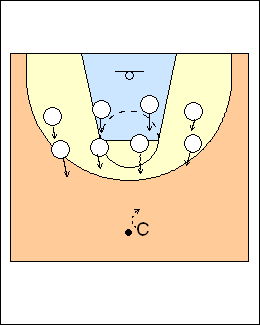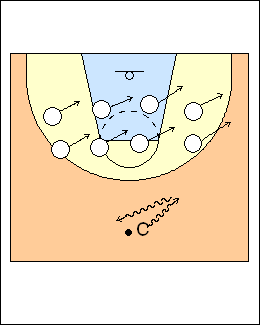Nash wave drill
 | 1 Steve Nash Coach spins a pass, defenders close out with arms up, get in defensive stance. Coach then fakes to drive left and right, defenders must jump to change the direction of their stance [hip turn]. (Option - hot feet) |
 | 2 Coach dribbles left and right, defenders slide. Coach shoots in the air back to himself, defenders yell "shot", pivot and box out. (Variation - coach holds the ball overhead with two hands, players yell "dead!" and smother.) David Faucher rebounding - when coach shoots, players put up a hand to contest the shot, turn, stay low, pretend to box out. Progressions - players work in pairs - 1 on 1. Renato Pasquali - players are in stance, coach touches the floor with the ball, players slap the floor with both hands and pitter-patter, - coach alternates ball fakes right and left, players make quick hip turns - coach jabs right, players open up and take one slide, coach puts the ball overhead, players recover with hands up, coach takes a crossover step left, players take one slide - coach tosses the ball in the air, players jump to contest a shot with both hands up, repeat - coach takes a hard dribble forward, other hand straight ahead in a fist, players take a charge - players get up, run to the other end. Jerry Petitgoue - stance drill - a) stance (hands wide, play big, feet about shoulder width), b) quick feet, c) quick turns, d) quick slides - 4 slides then quick feet, repeat coming back (don't cross feet, step, pull the other foot). Tony House - stance - foot fire - quick turns (point left - "Rautins", point right - "House") - shot fake - contest - pound ball on the floor - loose ball, players get down and up - dribble left, right - players slide - pick up the ball - "dead", trace the ball. George Karl - stance - on "go", three step-slides right, stance, repeat going left on "go" - three 45-degree retreat steps, drop step, repeat (coach diagonal advance dribbles, crosses over). - stance ("sit on a stool", knees bent, back straight, toes pointing forward, arms out, palms up) - stutter (hot feet) - slide - three slide-steps in the direction coach points - three diagonal retreat steps going left, then advance steps, repeat going right (coach holds a ball out on the diagonal, pulls it back in, changes hands and repeats) - take a charge (land on your butt, not hands) - stutter - "shot" (contest and box out). Jim Huber - 6 footwork progressions - foot fire, whichever shoulder coach points to, progressions: - quick turn, 45 degrees (don't open the gate) and come back (continue) - quick turn, two push steps, sprint back - quick turn, crossover and sprint (3 steps), square up, sprint back. Sébastien Roduit - on-ball defence is a wall between the ball and the basket for three dribbles, not forcing, permanent pivot foot slightly back (at a high level, defend a right-hander nose on his right shoulder). When the ball is down, move back, hand on the ball. Use a lateral not diagonal step to stop a drive (90% of the time a crossover start, to avoid a travel). Pass, close out, ball-up ball-down 3 times, then attack. Ettore Messina - the defensive stance is one foot slightly ahead of the other (toe to middle of foot), for maximum lateral speed it never changes, swing steps and drop steps are too slow. The straight-up position is nose-to-nose with the ballhandler, to force left or right, put your nose in line with the appropriate shoulder rather than changing the stagger of the feet. Close in as the ball goes up (arms up, legs stay in stance), step back as the ball comes down, keep the same stance, allowing you to move your wall laterally, don't drop step, he will attack your front foot. Arms can go out to the side without having to drop step and sacrifice lateral mobility. Taylor Allan - on-ball stance - the lowest man wins, it’s got to be a neutral stance (square), no attack angles, not leaving too much room, not too close so he can blow by, one hand shadowing the ball, one hand off. Wait and react, let him make his move then react to it, don't anticipate. If he puts the ball overhead, suffocate him, staying lower, waiting for him to come back down to drive. Once he puts the ball on the floor, close the gap, keep a body on him, play him with your chest not your hands, but don't jump too hard and fast or he will change directions (neutral defence, don't bite too hard). Randy Sherman - when the ball is out top, the on-ball defender should angle himself to influence the ballhandler to a sideline checkpoint where the foul-line extended intersects a sideline. The lead hand is in the passing lane, the drag hand is down to prevent a crossover dribble. |
This page was made with Basketball playbook from Jes-Soft